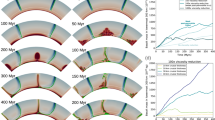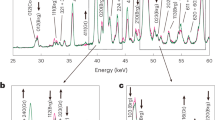Abstract
Seismological observations provide evidence that the lowermost mantle contains superposed thermal and compositional boundary layers1 that are laterally heterogeneous2,3. Whereas the thermal boundary layer forms as a consequence of the heat flux from the Earth's outer core, the origin of an (intrinsically dense) chemical boundary layer remains uncertain4. Observed zones of ‘ultra-low’ seismic velocity5 suggest that this dense layer may contain metals6,7 or partial melt8, and thus it is reasonable to expect the dense layer to have a relatively low viscosity. Also, it is thought that instabilities in the thermal boundary layer could lead to the intermittent formation and rise of mantle plumes. Flow into ascending plumes can deform the dense layer, leading, in turn, to its gradual entrainment9,10,11,12,13,14. Here we use analogue experiments to show that the presence of a dense layer at the bottom of the mantle induces lateral variations in temperature and viscosity that, in turn, determine the location and dynamics of mantle plumes. A dense layer causes mantle plumes to become spatially fixed, and the entrainment of low-viscosity fluid enables plumes to persist within the Earth for hundreds of millions of years.
This is a preview of subscription content, access via your institution
Access options
Subscribe to this journal
Receive 51 print issues and online access
$199.00 per year
only $3.90 per issue
Buy this article
- Purchase on Springer Link
- Instant access to full article PDF
Prices may be subject to local taxes which are calculated during checkout




Similar content being viewed by others
References
Lay, T., Williams, Q. & Garnero, E. J. The core–mantle boundary layer and deep Earth dynamics. Nature 392, 461–468 (1998)
Wysession, M. E. Large-scale structure at the core–mantle boundary from diffracted waves. Nature 382, 244–248 (1996)
Castle, J. C., Creager, K. C., Winchester, J. P. & van der Hilst, R. D. Shear wave speeds at the base of the mantle. J. Geophys. Res. 105, 21543–21557 (2000)
Gurnis, M., Wysession, M. E., Knittle, E. & Buffett, B. A. (eds) The Core-Mantle Region Monograph 28 (American Geophysical Union, Washington DC, 1998)
Garnero, E. J. Heterogeneity of the lowermost mantle. Annu. Rev. Earth Planet. Sci. 28, 509–537 (2000)
Knittle, E. & Jeanloz, R. The Earth's core-mantle boundary: Results of experiments at high pressures and temperatures. Science 251, 1438–1453 (1991)
Brandon, A. D. et al. Coupled 186Os and 187Os evidence for core-mantle interaction. Science 280, 1570–1573 (1998)
Williams, Q. & Garnero, E. J. Seismic evidence for partial melt at the base of the Earth's mantle. Science 273, 1528–1530 (1996)
Davaille, A. Simultaneous generation of hotspots and superswells by convection in a heterogeneous planetary mantle. Nature 402, 756–760 (1999)
Olson, P. & Kincaid, C. Experiments on the interaction of thermal convection and compositional layering at the base of the mantle. J. Geophys. Res. 96, 4347–4354 (1991)
Sleep, N. H. Gradual entrainment of a chemical layer at the base of the mantle by overlying convection. Geophys. J. Int. 95, 437–447 (1998)
Montague, N. L. & Kellogg, L. H. Numerical models of a dense layer at the base of the mantle and implications for the geodynamics of D”. J. Geophys. Res. 105, 11101–11114 (2000)
Farnetani, C. G. Excess temperature of mantle plumes: the role of chemical stratification across D”. Geophys. Res. Lett. 24, 1583–1586 (1997)
Tackley, P. J. The strong heterogeneity caused by deep mantle layering. Geochem. Geophys. Geosyst. 3, U1–U22 (2002)
van Keken, P. E. et al. A comparison of methods for the modeling of thermochemical convection. J. Geophys. Res. 102, 22477–22495 (1997)
Gonnermann, H. M., Manga, M. & Jellinek, A. M. Dynamics and longevity of an initially stratified mantle. Geophys. Res. Lett. 29, 10.1029/2002GL014851 (2002)
Neavel, K. E. & Johnson, A. M. Entrainment in compositionally buoyant plumes. Tectonophysics 200, 1–15 (1991)
Manga, M. & Weeraratne, D. Experimental study of non-Boussinesq Rayleigh-Benard convection at high Rayleigh and Prandtl numbers. Phys. Fluids 11, 2969–2976 (1999)
Sparrow, E. M., Husar, R. B. & Goldstein, R. J. Observations and other characteristics of thermals. J. Fluid Mech. 41, 793–802 (1970)
Davaille, A. Two-layer thermal convection in miscible viscous fluids. J. Fluid Mech. 379, 223–253 (1999)
Olson, P., Schubert, G. & Anderson, C. Structure of axisymmetric mantle plumes. J. Geophys. Res. 98, 6829–6844 (1993)
Turner, J. S. Buoyancy Effects in Fluids (Cambridge Univ. Press, Cambridge, 1973)
Lister, J. R. & Kerr, R. C. The effect of geometry on the gravitational instability of a buoyant region of viscous fluid. J. Fluid Mech. 202, 577–594 (1989)
Nataf, H.-C. Mantle convection, plates, and hotspots. Tectonophysics 187, 361–377 (1991)
Sleep, N. H. Time dependence of mantle plumes: Some simple theory. J. Geophys. Res. 97, 20007–20019 (1992)
Schaeffer, N. & Manga, M. Interaction of rising and sinking mantle plumes. Geophys. Res. Lett. 28, 455–458 (2001)
Neavel, K. E. & Johnson, A. M. Entrainment in compositionally buoyant plumes. Tectonophysics 200, 1–15 (1991)
Jellinek, A. M., Lenardic, A. & Manga, M. The influence of interior mantle temperature on the structure of plumes: Heads for Venus, Tails for the Earth. Geophys. Res. Lett. 29, 10.1029/2001GL014624 (2002)
Martin, D. & Campbell, I. H. Laboratory modeling of convection in magma chambers: Crystallization against sloping floors. J. Geophys. Res. 93, 7974–7988 (1988)
Steinberger, B. & O'Connell, R. J. Advection of plumes in mantle flow: implications for hotspot motion, mantle viscosity and plume distribution. Geophys. J. Int. 132, 412–434 (1998)
Acknowledgements
We thank A. Davaille for comments on the previous version of the manuscript, and L. H. Kellogg, R. C. Kerr, M. A. Richards and N. Sleep for comments on earlier versions. This work was supported by the National Science Foundation and The Miller Institute for Basic Research in Science.
Author information
Authors and Affiliations
Corresponding author
Ethics declarations
Competing interests
The authors declare that they have no competing financial interests.
Rights and permissions
About this article
Cite this article
Jellinek, A., Manga, M. The influence of a chemical boundary layer on the fixity, spacing and lifetime of mantle plumes. Nature 418, 760–763 (2002). https://doi.org/10.1038/nature00979
Received:
Accepted:
Issue Date:
DOI: https://doi.org/10.1038/nature00979
This article is cited by
-
A thin mantle transition zone beneath the equatorial Mid-Atlantic Ridge
Nature (2021)
-
The evolution of basal mantle structure in response to supercontinent aggregation and dispersal
Scientific Reports (2021)
-
The Earth’s mantle in a microwave oven: thermal convection driven by a heterogeneous distribution of heat sources
Experiments in Fluids (2017)
-
A rapid burst in hotspot motion through the interaction of tectonics and deep mantle flow
Nature (2016)
-
Broad plumes rooted at the base of the Earth's mantle beneath major hotspots
Nature (2015)
Comments
By submitting a comment you agree to abide by our Terms and Community Guidelines. If you find something abusive or that does not comply with our terms or guidelines please flag it as inappropriate.



